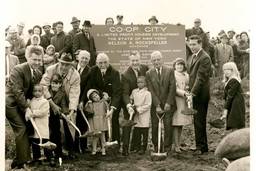
Some tents. Some protesters.
Zuccotti Park?
Five protesters dead. Police cars burned. Barricades in the streets. Hundreds of thousands of workers on strike. Protests across the country.
Not Zuccotti Park.
It’s Gezi Park, adjacent to Taksim Square, one of only a few remaining public green spaces in Istanbul. When bulldozers appeared at Gezi Park on May 28, a progressive coalition called “Taksim Platform” put the word out to supporters that the government was moving forward with its plan to raze the park in order to build a shopping mall.
Built in the 1920s as a “prestige project” for the post-Ottoman Turkish Republic, Taksim Square has long been a battlefield for Turkey’s identity. The square houses the Monument to the Republic, built in 1928 to celebrate the five-year anniversary of IDAtatürk’s secular, modern state. And as the site of rallies and demonstrations for decades, Taksim is also the beating heart of Turkish labor and social movements. Generations of workers have duked it out with the police and military on the square’s paving stones in the struggle for freedom and democracy.
But perhaps the real significance of Taksim Square is more banal: Every week, thousands of young Istanbul residents study, converse, break bread, drink, flirt, and relax together in the square and its environs. Taksim Square has always been the house of the people.
The plans of Turkish Prime Minister Recep Tayyip Erdogan to remake the square are emblematic of his plans to remake all of Turkish society. A cultural Islamic conservative who has restricted sales of alcohol and infused the secular education system with religious influence, Erdogan has simultaneously redistributed wealth to the poor by broadening healthcare access and establishing other social programs for his electoral base, and helped the super-rich with cronyist real-estate schemes, gutting regulations, and courting foreign investment and trade. It’s a delicate formula that relies on luring foreign capital to Turkey in order to generate economic growth, which can help defuse social tensions. But since 2003, it has been effective enough to keep Erdogan in power.
Erdogan’s economic formula isn’t perfect. Almost 40 percent of Turkey’s population lives in dire poverty, making less than the monthly minimum wage of 773 liras ($415.19). Youth unemployment oscillates around 18 percent. According to Middle East Quarterly, over the past year employment in the formal sector shrank by 5 percent. Consumer debt has increased by 40 percent since 2012. Income inequality is ballooning, with the richest 20 percent of the population receiving more than half the income, and the poorest 20 percent receiving only 6 percent. Such inequality is exacerbated by a regressive reliance on sales taxes.
Turning Gezi Park into a shopping mall was only one of a slew of unpopular large-scale development projects that amount to what geographer David Harvey calls “accumulation by dispossession” in the city, privatizing public goods and pushing residents off their land in order to clear the way for capitalist investment. Erdogan aims to redevelop Istanbul as what urban theorist Mike Davis has termed an “evil paradise,” a haven for the exploitation of workers, unfettered by the regulations and labor organization, allowing income inequality to soar like the speculatively-financed skyscrapers casting a shadow on the shantytowns below.
But with his bid to reshape Taksim Square, the heart of the city, Erdogan may have gone too far.
The Taksim Square Massacre
The Turkish working class’ ties to Taksim Square run deep. On May Day in 1977, hundreds of thousands of workers gathered at the square to hear a speech by Confederation of Revolutionary Trade Unions of Turkey (DISK) President Kemal Türkler. Influenced by socialist and Marxist doctrines, DISK had been formed a decade earlier as a left-wing split from the apolitical Confederation of Turkish Trade Unions (TÜRK-İŞ).
After shots rang out from the nearby Ceylan Intercontinental Hotel, pandemonium ensued. Police vehicles drove into the crowd, sirens blaring, and in the panic, 34 people were shot or crushed to death. To this day, no one has been brought to justice for the killings, although many activists allege collusion between the Turkish government, right-wing extremists and the CIA. The Taksim Square Massacre was a prelude to the coup d’etat against the Turkish government in 1980, establishing military rule.
The military junta banned May Day demonstrations in Taksim Square, seized DISK’s assets and proscribed the organization. The state indicted 1,477 union activists on charges of “attempting to demolish the constitutional regime,” sentencing them to prison terms between five and 15 years. Türkler was assassinated in front of his home by right-wing militants in broad daylight. The government passed repressive new labor laws, drastically undermining workers’ right to organize and strike, and seeking to force workers into the reformist TÜRK-İŞ union.
The military also intensified the persecution of Turkey’s Kurdish minority, banning the Kurdish language from government institutions even though Kurds made up around 18% of the country’s population. In response to systemic oppression, in 1984 the Kurdish Workers Party (PKK) launched a guerrilla war against the Turkish state for national autonomy. Over the subsequent two decades, the war has claimed the lives of more than 40,000 people, while providing the Turkish state with justification for harsh repression of social movements.
After fighting for more than a decade, DISK won an acquittal for the 1980 indictments and was able to resurface as a labor organization in 1992. But despite the de jure existence of a constitutional democracy, the Turkish state has continued to repress social movements.
Over the past two decades, more than 16,000 complaints against Turkey have been filed at the European Court of Human Rights over government violations of free speech, freedom of the press, freedom of association and other inalienable rights. According to Reporters Without Borders, 70 reporters are currently “languishing in Turkish jails,” earning Turkey rank of 154th out of 179 countries in terms of press freedom.
Labor rights violations are also endemic, with the government frequently branding typical union organizing activities as “terrorism.” So far in 2013, police have jailed hundreds of trade unionists, particularly those active in KESK (the public sector union). Turkish law requires unions to receive police permission before holding a union meeting, and police are allowed to record all meeting proceedings. The restrictive political environment presents extreme challenges for organizing, resulting in a decline in union density from 10.6% in 1999, to only 5.9% in 2011.
Prelude to Revolt
Taksim Square has been at the center of the struggle every step of the way. Since 2006, each May Day workers have clashed with police while trying to march to Taksim Square to commemorate the 1977 massacre and renew the struggle for a better life. In response to pressure, the Turkish government voted in 2009 to reinstate May Day as a national holiday, and granted certain union leaders permission to hold a ceremony at the site.
It was a foot in the door. Since 2010, May Day marches to Taksim Square have grown in size every year. In 2011, more than 200,000 workers marched in a joint demonstration organized by Turkey’s four labor confederations. In 2012, more than 600,000 workers took the streets. Taksim Square is also often the center of demonstrations for womens’ rights, LGBTQ rights, against environmental destruction, and many other issues. Last fall, Taksim was the site of a sit-in in solidarity with more than 1,700 Kurdish political prisoners who were on hunger strike for the right to speak their own language and freedom for imprisoned PKK leader Abdullah Öcalan.
It is also where Erdogan lit the fuse that ignited the unrest currently roiling Turkey. Citing construction work on his pet project to radically reshape the area, he followed in the footsteps of the 1980 military dictatorship and banned May Day demonstrations at the Square, reversing the policy of 2009. To underscore his adamance that protesters stay away from the construction work, he deployed more than 3,000 riot police to the area.
It didn’t sit well with Turkish trade unionists, who defied the ban. Thousands of workers, joined by socialists, communists, Kurdish nationalists, self-described Islamic anticapitalists, feminists, LGBTQ activists and environmentalists attempted to march on the square on May Day.
The police responded with batons, tear gas, rubber bullets and concussion grenades. The extraordinary police repression evoked comparisons to the military interventions of previous decades. General Secretary of the ITUC Sharan Burrow writes, “Drivers of buses picking up workers in factories had their driving licenses confiscated by police, and bridges across the Golden Horn dividing the city of Istanbul were raised for the first time since 1970 to stop workers making their way to Taksim Square.”
In total, more than 200 workers were injured by the police, who also made more than 70 arrests. But the government wouldn’t have the last word.
Occupy Gezi
Around 50 activists responded to Taksim Platform’s call on May 28, setting up tents in Gezi Park to block the bulldozers.
The cops pepper-sprayed the assembled crown. It was a bad PR move. One iconic image of police tear-gassing a genteel-looking woman in a red dress at point blank range quickly circulated across the Internet. Rather than smother the movement, the police repression ignited a tinderbox of discontent. By the next evening, more than 3,000 people had occupied the park. The atmosphere was festive, with many openly defying the new ban on drinking alcohol in public.
At 4:30 a.m. on May 30, the repression began in earnest.
Activist Kıvanç Eliaçık reports, “When I woke up in the morning the camp was drowned in tear gas and everyone was running around. The police set the tents on fire. They uprooted the saplings that were planted a day before. The bulldozers were working under the protection of riot police.”
But the people didn’t back down. More protesters took to the streets, facing off against riot police. By evening, volunteer doctors at Taksim Square reported more than 1,000 injuries.
One participant, who asked to be identified only as “a Chapuller” (a nod to Erdogan’s denigration of the protesters as “capulcular,” the Turkish word for “looters”) said, “The pictures of brutality spread all around… then it became a revolt. A revolt against 10 years of wrongdoings of the government. Against massacres at Roboski of Kurdish people, against not allowing any protest, against the brutality at the 1st of May, against the alcohol ban, against so-called ‘renewal projects’ that aim to destroy working class Gypsy and Kurdish districts and turn them to shopping malls or residences. It is against all the sexist policies like anti-abortion policies, it is against the destruction of forests at Black Sea region to make hydroelectric plants, it is about not wanting nuclear plants… Every single thing that people here just had to take exploded. It was about ‘a few’ trees, but they symbolized a lot more than that.”
A social movement had been born.
Still, the government refused to back down. At 4:30 a.m. on May 31, police unleashed their most savage attack yet. They drenched Taksim Square in tear gas and other chemical weapons. One protester suffered a non-fatal heart attack, and a teacher broke her arm. Again, more protesters flooded the streets, battling police to regain control over the square.
News spread fast through Istanbul’s neighborhoods, and a plebeian army began to form to re-take Taksim. Thousands of demonstrators marched across the Bosphorus Bridge that links the Asian and European sides of the city. They defied tear gas and concussion grenades, crashed through police barricades, surging toward Taksim Square.
Protests spread to Ankara and Izmir, sparking additional clashes with the police. As the weekend began, the depth of the movement’s resonance with Turks became clear.
Hundreds of thousands of people demonstrated in cities small and large across the country demanding the resignation of Erdogan’s government. It was a movement of movements, solidarity overflowed the furrows that had formerly divided Turkish society. Anarchists, trade unionsts, feminists, Kemalists, and Kurdish autonomists found unity in the streets. At around 1pm on Saturday June 1, Istanbul was gripped by the clanging clamor of thousands of residents beating pots and pans, evoking a comparison with the casseroles of Quebec in 2012 and Argentina in 2001.
Perhaps realizing that further brutality would only bring people into the streets, the police left Taksim Square, which has become an autonomous zone in the middle of Istanbul. Without the guidance of political parties or unions, protesters have developed a system of self-management in the square. Cleaning patrols keep the area squeaky clean, and activists have discouraged the consumption of alcohol in order to keep the space welcoming to all.
Erdogan’s government has oscillated desperately between condemnation of the protests and half-hearted attempts to appease the protestors with apologies. The embattled Prime Minister still insists on plans to go ahead with the destruction of Gezi Park, characterizing the movement as “vandals” and “extremists,” and blamed Twitter and “foreign plotters” for the rebellion. Thirty-three people have even been arrested for protest-related tweets. But if Erdogan thought things were bad, they were about to get a lot worse.
Labor Strikes Back
On June 4, the Public Workers Unions Confederation (KESK) announced that its 240,000 members would go on strike for two days and asked its workers to wear black to show solidarity with the demonstrators. DISK called for a general work stoppage on June 5, potentially bringing hundreds of thousands more workers into the struggle. They have joined flight attendants at the 49% government-owned Turkish Airlines, who had already walked out on May 15 over substandard pay and moves toward asserting conservative cultural Muslim values at the airline. Influenced by Erdogan’s party, management has sought to ban certain shades of lipstick and ban the sale of alcohol on flights.
With the entry of the labor unions into the struggle, the protesters gain a heavyweight ally. It was the general strike of the Egyptian working class in 2011 that pushed Mubarak’s government over the edge. But Taksim is not Tahrir. The two-day strike has not escalated into a general strike, and the movement is on the defensive. This past Tuesday, police launched a renewed assault on Taksim Square. A pitched battle raged well into Wednesday, with protesters answering the cops’ tear gas and rubber bullets with Molotovs, rocks, bottles, and wooden shields. Ultimately, protesters prevailed, as thousands re-occupied Gezi Park and Taksim by Thursday.
Faced with a defeat in the streets, Erdogan issued an ultimatum in a television broadcast, “I’m making my last warning: mothers, fathers please withdraw your kids from there. Gezi Park does not belong to occupying forces. It belongs to everybody.”
Contradicting his threat to send police into the square again, Erdogan then met with representatives of Taksim Solidarity later that evening.
After the meeting, a representative of the protest group told reporters, “The prime minister said that if the results of the public vote turned out in a way which would leave this area as a park, they will abide by it. His comments that the project will not be executed until the judiciary makes its decision is tonight’s positive result.”
It is a victory, but it remains to be seen if the concession from Erdogan will demobilize the movement. The rebellion has come to signify much more than the defense of 600 trees in Gezi Park. It is a refusal of neoliberalism, repression of trade unions and social movements.
If the protests do re-escalate around broader demands, the rebellion will have much more than Turkish neoliberal elites to deal with. Like Egypt’s Mubarak, Erdogan is a close ally of the United States, which has given Turkey more than $12.5 billion in economic aid, and over $14 billion in military assistance. Turkey hosts U.S. military bases and serves as a pro-West bulwark in the region. The foreign policy commentariat voices the dominant perspective among U.S. elites, who see in the rebellion an affirmation, rather than a rejection, of Western capitalism, an episode of growing pains in Turkey’s evolution as a liberal European society. For them, neoliberal capitalism is what Francis Fukuyama called the “end of history,” the best of all possible worlds to which there is no alternative. They will do what they can to turn any potential regime change into a “velvet revolution,” ensuring that any new boss looks a lot like the old boss.
Whatever the coming weeks hold, it’s clear that this is not the first, and will surely not be the last, mass uprising as youth unemployment, rampant corruption, austerity, and rising food prices generate enormous social tensions around the world. Can we go beyond the end of history? No one knows the answer, but it is clear the best place to look for a way forward is in revolt.







